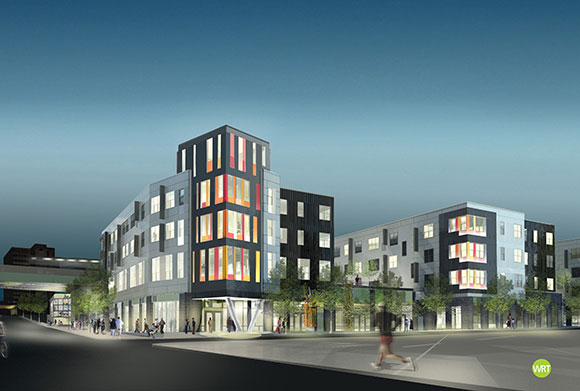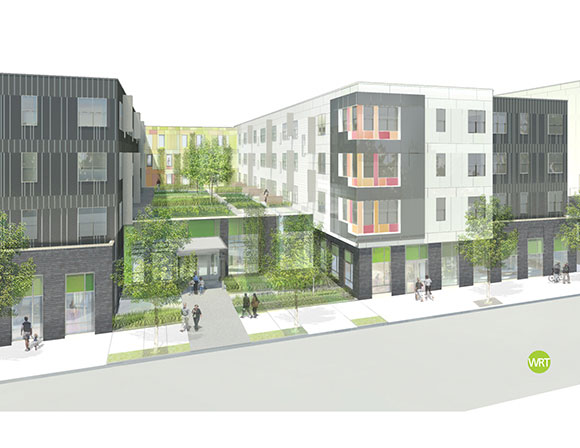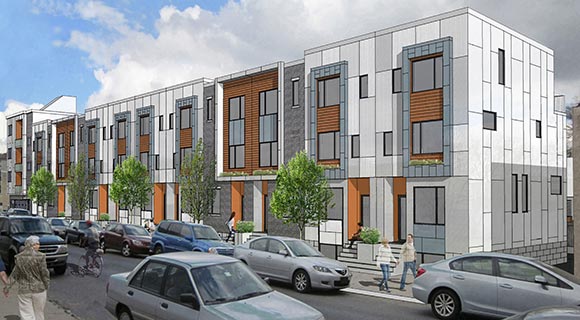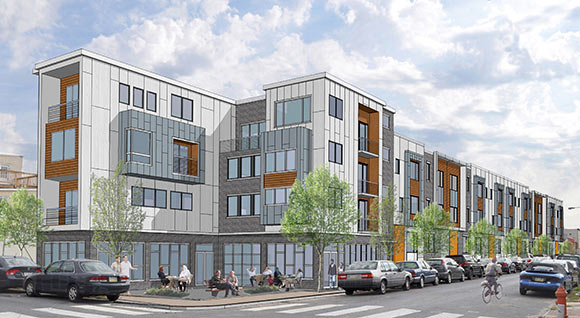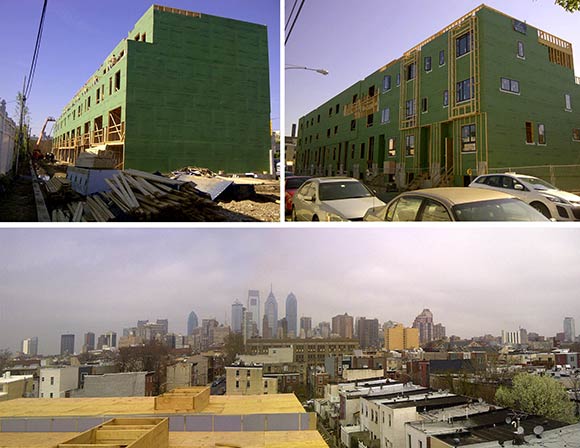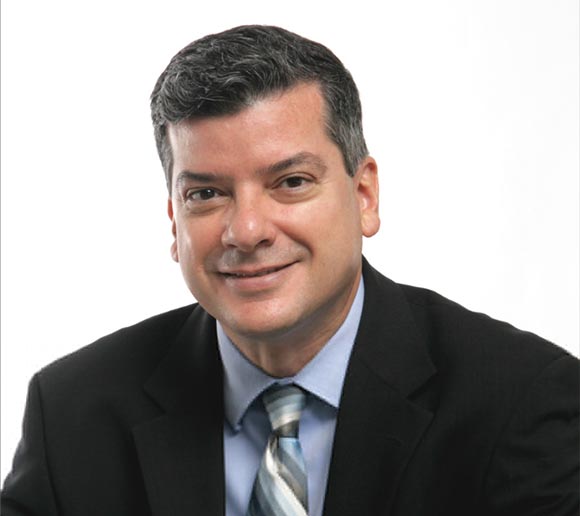In the race to become the “Greenest City in America” Philadelphia has several advantages: walkable neighborhoods, established green spaces, community gardens and a thriving local foods system.
But when it comes to sustainable housing, the city ranks fourteenth in the nation (according to a recent Environmental Protection Agency report). Fortunately, that's starting to change. Thanks to forward-thinking architectural firms such as Onion Flats, PostGreen and Re:Vision, Philly has an increasing number of residential projects certified LEED Platinum, the highest sustainable design designation a building can receive.
While some of these structures are single-family homes, others are ambitious multi-unit, mix-use complexes with open green spaces and concealed parking lots. This building philosophy is having a deep impact on the way neighborhoods look and feel, bringing a modern sheen and sustainable ethos to Philadelphia's historic brick-rowhome-dominated streetscape.
Mixed use in Graduate Hospital
Chris Stromberg of Johnston Stromberg Architecture once considered the site of his current project, Carpenter Square, the “armpit” of Graduate Hospital. The long-abandoned block at 17th and Carpenter Streets, bordered by warehouses, will soon be home to 11 town houses, six condos, and a corner commercial space built to the LEED Platinum standard. The project, created in partnership with the Goldenberg Group, is expected to be completed this fall.
“It was hard to see anything happening there,” says Stromberg. “Something big had to happen in order to turn things around.”
By creating an ambitious mixed-use plan, Stromberg aims to earn Platinum Neighborhood Development (LEED ND) certification, an honor given to a block or series of blocks.
Stromberg, who is also co-founder of the custom furniture company Bench Dog Design (they use only salvaged and sustainably-sourced wood), is a nine-year resident of the neighborhood. He has renovated 15 local houses, starting with his current home at 16th and Montrose Streets. When the Redevelopment Authority put out a Request for Proposals for the Carpenter site — just one block from Stromberg's house — he lept at the opportunity. Stromberg eventually teamed up with the South of South Association Neighborhood Association (SOSNA), where he's an active member of the zoning committee, to tackle this project.
“There were some rumblings in our neighborhood about different people wanting to develop it,” recalls Stromberg. “We said, 'Hey let's get together, pick an idea.' A lot of it came from years of cataloguing what the neighborhood wants and needs.”
In addition to standard energy-saving amenities, the homes will boast a passive heating and cooling strategy — a central air shaft will lead to skylights (which automatically close when it rains), creating a cross-breeze. An energy recovery ventilator brings fresh air into the house.
“As opposed to relying on technology to do all of it, we tried to design the houses to exist comfortably on its own,” he explains.
For Stromberg, mixed-use isn't just a building trend, it's a way to bring activity back to this “bedroom” community. He hopes new commercial space will penetrate the Washington Avenue post-industrial “dustbowl” that separates Graduate Hospital from Point Breeze and Newbold.
“It's already happening,” he says. “Vacant and abandoned properties in the neighborhood are starting to be renovated.”
Thinking “small” in Newbold
South Philly wasn't on the agenda for PostGreen, the green building gurus behind First Steel and the 100K House in Kensington. But then John Longacre, local developer and owner of the South Philadelphia Taproom, approached the team about a vacant block at 16th and Moore Streets. ReNewbold, a 19-unit project PostGreen designed with Interface Studio Architects (ISA), breaks ground this summer.
“South Philly around East Passyunk has really developed over the last ten years,” says Chad Ludeman, founder and president of PostGreen. “Back when we did the 100K House, activity was picking up in surrounding neighborhoods. Now there's a lot going on around there. The Newbold neighborhood reminded us very much of where we started in East Kensington.”
Up until now, PostGreen has worked in exclusively the Riverwards, an area filled with large vacant parcels (a relic of the neighborhoods' industrial past). To adjust to South Philly's dense cityscape, homes need to be smaller, with lower price points.
“We knew we needed to develop a new model,” says Ludeman. “We worked with ISA to take everything we've learned — from the 100K house to what we've been doing now – to create the most efficient home for the buyer.”
To meet these challenges, PostGreen adapted an ultra-compact layout they'd developed for the First Steel project. Their trademark ethos — energy-tight envelopes — means triple-pane windows, advanced air ceilings and exterior insulation. With ReNewbold, PostGreen paid close attention to sustainable, chemical-free flooring products and finishes. They've also included low-flow bathroom fixtures and appliances.
At 1,000 to 1,500 square feet, the two and three-floor houses are a throwback to the 19th century working-class homes that surround them. (By comparison, most new construction homes in Philadelphia have 2,000 to 2,500 square feet).
“Obviously ReNewbold doesn't look like anything else in the neighborhood,” says Ludeman. “But these homes are much closer in scale with what's there. People just don't build those anymore.”
A new hub in North Philly
LEED is often linked with high-end housing, but sustainability doesn't have to be a luxury. Paseo Verde, the legacy project of the Asociación de Puertorriqueños en Marcha (APM), is bringing platinum-certified, market-rate and affordable housing — plus social services and retail space — to a North Philly transportation hub. When construction is completed this month, the 164-unit development — created by Jonathan Rose Companies and Wallace Roberts & Todd (WRT) Architects — will become Philly's first LEED ND.
Years before Paseo Verde broke ground, APM was laying the foundations for a sustainable community. In 2003, the neighborhood empowerment group developed a “master plan” that created new green spaces and encouraged commercial investment, including the Gateway Plaza. They targeted Paseo Verde's adjacent transportation hub, the Temple University Regional Rail stop, for future development.
“What made it really natural to aim for LEED ND is that APM has done exactly what LEED ND calls for,” says Antonio Fiol-Silva, the project's lead architect. “They wanted to provide housing that was of greater density around transit-oriented development.”
With a mix of layouts and prices (and 95 bicycle parking stops), AMP is diversifying the area's housing stock.
“It could be a neighborhood for younger people who could rent housing,” says Fiol-Silva. “Later on, when they have kids, they can move on to larger housing with yards.”
The development is being built in a flood hazard zone and has major stormwater management challenges. The designers included an extensive filtration system that supports multiple gardens and over-an-acre of green roofs. They've also built Philly's first blue roofs, a passive technology that collects rainwater in pools and slowly releases it.
Paseo Verde also makes ample use of natural light — there is glass throughout the homes' hallways and stairwells. Windows face open courtyards. The project even connects to the regional rail stop through a big open window, highlighting the transit-oriented nature of the development.
“The building is not a wall separating it,” says Antonio. “You can see right through into the neighborhood.”
DANA HENRY is sister publication Flying Kite's Innovation & Job News editor. Send feedback here.
